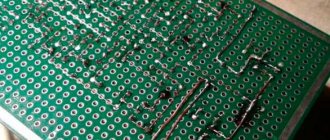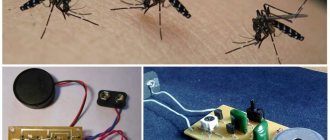Probably many people have thought about how to make a homemade radio bug for wiretapping. On the Internet you can find many instructions and diagrams for making radio bugs, but some of them are too complex for beginner radio amateurs, may contain hard-to-find elements, or may not work at all at the output.
Here is a description of assembling a radio bug for beginners, although this scheme may also seem difficult to implement, this is not at all the case. This radio bug is quite small in size; the power of the device depends on the choice of transistor.
The range of the receiver given in this article is about 100 meters, which is a good indicator for homemade work.
How to make a bug with your own hands: diagram and detailed description
In order to organize wiretapping, you can resort to several ways to implement your plans. Electronic tracking devices can be purchased in stores or ordered online. However, a high-quality industrial design will cost the consumer a pretty penny. As a rule, cheap Chinese devices quickly break down, and they don’t particularly stand out for their practicality. There is only one thing left - to make a bug with your own hands, especially since this is quite feasible, and the cost of components (in order to manufacture this or that audio surveillance device) is essentially symbolic. Anyway, let's get down to business.
Where are wiretapping and hidden cameras located?
The most popular “spy things” are video cameras for secretive video surveillance, GPS trackers, and spy software for smartphones.
The most commonly used radios are portable radios and GSM bugs, which operate by transmitting FM waves to help receive information over long distances. The GSM model with a SIM card functions like a telephone. The signal reception radius is not limited by anything. The most convenient way of tracking is to insert radio microphones into objects in plain sight, drill holes in cornices, baseboards, and frames. Common bookmark places:
- Appliances;
- interior items - vases, souvenirs, flowerpots, chandeliers;
- switches, extension cords, sockets;
- ventilation holes;
- Stuffed Toys;
- tabletop. Brands produce listening devices in the form of stationery, which allows you to keep a pen or pencil with a voice recorder on your desk. The bug can sit in a USB cable, be fed with a resource through a USB connector and constantly scan the space. Many digital spies operate on batteries, so they need to be changed periodically. Pay attention to the equipment connected to the router. Spy gadgets are often inserted into the network. They have a SIM card or Internet access from their point of contact, and transmit information through a personal network. The danger increases in the vicinity of a Wi-Fi network with a strong signal.
You don’t have to look for a bug in a wardrobe, chest of drawers or under a mattress due to poor hearing. If the object is being monitored through sensory surveillance, the video camera is hidden at a height.
Legal grounds
Of course, you need to understand that special means for wiretapping are the prerogative of the intelligence services. In case of violation of the constitutional rights of the individual and proven guilt in violating the secret of private life, administrative punishment will follow. There are often cases when it comes to criminal liability. Therefore, you should not “abuse” the manufactured product. It is much wiser to use such a device as an additional means of security or to use it to implement acoustic control over the territory of your own home. For example, a home-made wiretapping bug will be an excellent “informant” if you are not sure of the integrity of the nanny you hired or want to know what is happening in class at school. There are many situations in life when the use of listening devices becomes a necessity.
Listening device model R600
One of the first models to appear on the spy device market. The GSM bug generates clear, high-quality sound and works for a long time. The adapted version of R600 allows you to conduct audio surveillance with greater comfort. In reviews of the wiretapping bug, users note its simple design and ability to be used in any conditions. The device is activated by calling the installed SIM card.
Mobile “GSM bug”: an incredibly simple solution
In order to make a listening device from a cell phone, you need a device that supports the “Auto-hook up” function, and you also need a headset (headphones). The Nokia 1280 can be considered the most suitable device for such purposes, since the simplicity and reliability of the phone allow us to count on the success of the implemented project. By the way, a black and white screen is a sign of efficiency; the device’s energy consumption is significantly reduced. Believe me, such a phone bug, configured with your own hands, is an excellent substitute for expensive listening equipment. Moreover, literally everyone can perform the simple actions described below. Let's get started.
- Go to the phone menu and enter the “Call Mode” section.
- Create your own personal regime. All items related to light indication, vibration, volume of the signal melody, screen saver, sound of button presses and notification of an incoming SMS message must be deactivated.
- Give the new mode a name.
- Through the main menu, find the “Setting up accessories” section, which usually has two sub-items “headset” and “hearing aid”. In each of them, it is necessary to edit the operating parameters and the question of how to make a bug will be practically resolved.
- All “accessory” items must be included. Assign the newly created mode as active and exit the settings.
- Cut the cord from the headphones and insert the plug into the headset jack.
- The display should show the activated mode.
Price
The price of a wiretapping bug depends on its functionality and purpose: the simplest listening devices can be purchased for literally a couple of dollars. Devices with GSM/GPS tracking beacons, geolocation functions, communication with violators, video recording and other options will cost a large amount.
The price of a wiretapping bug depends on the following criteria:
- dimensions of the device;
- microphone sensitivity;
- number of built-in microphones;
- standby, recording and listening time.
Using a smartphone for purposes other than its intended purpose
When you go on a business trip or vacation, you can leave a kind of watchman at home, a mobile “security guard,” so to speak. Moreover, you don’t need to solder anything, and the cellular bug is a converted smartphone with your own hands. Everything else is simply primitive.
- Almost all smartphones are equipped with the “Auto-receive calls” function.
- Relatively new cellular units implement energy-saving mode technology. Therefore, if you take into account the known good condition of the device, you can count on 5-7 days of battery life.
- An option is possible when the phone is connected to the charger, and a special device with a time relay acts as an intermediary between the outlet and the charger. An hour a day is a completely acceptable energy supply mode (taking into account the situation described above).
- Turn off the sound notification, light indication and vibration mode on your phone.
- It would not be superfluous to take such an action as installing headphones into the headset jack, since the sound background around the caller will be an unfavorable signal that will predetermine the location of the spy device.
- Place the device in the middle area of the living space. Don’t forget: the device should not be in a visible place, but a wardrobe is not a solution either. Place your phone on the mezzanine or attach it to the back of a hanging picture.
How to find a wiretap using a smartphone
If you suspect the presence of spy gadgets in your home, first conduct a visual inspection. Carefully check lighting fixtures and household appliances that serve as a power source for microphones. Then try to detect the device using your smartphone. Walk around the room while talking. Please note that cracking and gurgling noises may be heard in certain areas. These are the sounds that analog bugs make. They pick up voice vibrations, transform them on the air and produce them in a distorted form. However, high-quality digital equipment is not so easy to find.
During scanning, radio microphones do not respond to phone signals and do not show themselves in any way. For identification, a field detector is needed - an anti-bug. Operating in a wide range of frequencies allows it to record the operation of tracking devices and Wi-Fi transmitters.
Wiretap bug: do-it-yourself using “improvised means”
As a rule, old phones are not thrown away. Find your long-forgotten “electronic companion”, because it is from this that you will make an effective sound-catching device. It is worth noting that almost any phone can be converted into a listening device. However, size plays an important role in the “life of a spy.” Therefore, in such a delicate matter as wiretapping, it is more advisable to use small phone models.
General sequence of actions
- You are disassembling the phone.
- Remove the screen and remove all LEDs (keyboard backlight - leave one for visual control).
- Solder in the power button.
- Install the device - “Automatic call answering”, because the bug must pick up the handset with its “hands”.
- Replace the microphone with a more sensitive one (electret).
- Extend the antenna (regular copper wire 15-20 cm).
- Solder the battery and fix it on top of the keyboard pad (rubber band, tape).
- Check the functionality.
The optocoupler shown in the diagram can be replaced with a transistor like KT315 or Western analogues S9018, S9014. In this case, the capacitor is removed and a resistor is installed with a resistance value of 2.2 k.
Miniature bug
You can make an FM transmitter with your own hands. A fairly simple circuit will allow you to receive a signal in the radio frequency range 88-92 MHz. You shouldn’t immediately run to the store and buy parts; perhaps you have faulty electrical equipment, from the board of which you can remove the necessary components.
- Bipolar transistor - 2N3904 or its equivalent.
- Resistors - 4.7 and 330 kOhm.
- Capacitors - 4.7 pF, 1 and 22 nF.
- Trimmer capacitor, rated 30 pF.
- Contour coil - winding diameter 6 mm, eight-turn, wire 0.5 mm.
- The material for the board is foil fiberglass.
- 9 W "Krona" type battery.
- Electret microphone (the most sensitive is used in tape recorders).
Collecting a radio bookmark
The result is a small and easy-to-make homemade wiretap that can be easily hidden in an inconspicuous place. However, this model has a small drawback - the antenna is 50 cm long. This is not entirely convenient if you want to hide the device as much as possible.
Connecting components according to a given diagram
How to make a radio bug for listening:
- Let's cut a rectangle measuring 53 mm by 75 mm from thin plywood or textolite. Homemade wiretapping will be based on it;
- we will make coil L1 from copper wire with a cross-section of 0.3–0.5 mm, winding eight turns onto a knitting needle with a diameter of 30 mm and leaving the ends 1.0 cm;
- From the same wire we will weave two two-terminal networks C2 and C3. Each is 1.8–2 cm in size. We straighten the upper ends in different directions and tin the lower ends;
- for the choke, take a copper wire with a cross-section of 0.05–0.1 mm and wind it tightly onto a match. The height of the wrap is approximately 6–7 mm. We cut the match to a length of 1.0 cm, make slits at the top and bottom in which we secure the ends of the wire;
- The antenna is made from a cable 50 cm long in plastic insulation, wound in a spiral.
You can buy a microphone at a radio store or take it from an unwanted cell phone. To correctly position the parts on the base, you will need a wiretapping bug diagram. Let's transfer it to plywood. According to the drawing, we will make holes for the parts and insert them. On the opposite side we solder all the parts strictly according to the diagram.
Assembling an FM bug for wiretapping
- First of all, the trimmer capacitor is soldered in (middle of the board). The transistor is mounted on the left.
- Moving to the bottom, we install (from left to right) capacitors: the first - 4.7 pF, the second - 1 nF.
- Now we solder in the resistors.
- After that - a 22 nF capacitor and a frameless coil.
- The design is completed by the wire - antenna, installation of a microphone and soldering of the battery.
In conclusion
Now it’s no secret to you how to make a bug out of a phone and what is needed for this. The options for GSM and radio products presented in this information review are only a part of the many available electronic samples through which you can establish high-quality acoustic monitoring. However, it should be noted that practicality and quality are achieved through the application of the above recommendations. However, perhaps there will be a “folk craftsman” who will come up with a more rational way to realize the excellent performance characteristics of his listening-type inventions. Well, for now we will use what we have. Listen carefully!
Simple DIY radio bug
On the Internet you can find a huge number of radio bug circuits. Some circuits are too complex and require configuration, others include scarce radio components, and still others don’t work at all!
I bring to your attention a diagram of a bug that can be assembled by both an experienced radio amateur and a beginner in this matter.
Let's look at this diagram:
Ignore the dotted line for now.
To make a bug we will need the following parts:
- VT1 - kt315 with any letter index (if you want to increase the range of the bug, it is better to use a microwave transistor, for example kt325 or kt368, the imported transistor s9018 is perfect);
- C1, C4 – 47...68nf;
- C2, C3 – 10pf;
- R1 – 33 kOhm;
- R2 – 100 Ohm;
- Oscillatory circuit L1 - 8 turns of copper wire with a diameter of 0.3...0.5 mm on a rod from a helium pen, wind carefully, turn to turn (I unsoldered the finished coil from a broken radio).
- M1 – electret or condenser microphone.
To save space, I used the right microphone (I found it in an old cell phone). Despite its size, it turned out to be very sensitive.
All parts except the L2 choke and microphone are shown in the following picture:
To make L2 we need a match and very thin wire:
We measure one and a half centimeters of matches, bite them off - this piece will serve as the core of the choke. Next, take the wire and wind one hundred turns. We fix the terminals of the resulting coil, clean it of varnish, and tin it. That's it, throttle L2 is ready!
When all the parts are assembled, you can start making the printed circuit board.
To do this, we need a 35x15mm piece of PCB and the solution itself in which we will etch the board (I used hydrogen peroxide + citric acid). Making a drawing of the printed circuit board (I drew it for the s9018 transistor)
Place the board in the solution and wait until the excess copper disappears.
After the board is etched, we take it out, rinse it with running water, remove the varnish and tin it:
Next, solder the parts in accordance with the diagram. Attention, when installing parts on the board, do not overheat them, otherwise they will fail! Be especially careful when installing VT1.
I would like to say a few words about connecting the antenna; the signal is supplied to it from the emitter of the transistor, which makes the operating frequency of the bug more stable.
The bug can be powered in the range from 1.5 to 9 volts.
Any of these batteries will be suitable to power the circuit. I used a AAA AA battery to make the bug more compact. You can also use a 3-volt “pill”.
If you will power the circuit from the crown (9 volts), then you should include a 100 Ohm resistor R3 in the circuit.
Carefully solder the battery to the bug. An insulated wire 30 cm long can be used as an antenna, but practice has shown that its absence will not greatly affect the reception range of the circuit. That's it, the bug is ready!
Now turn on the radio and look for the frequency of our bug. The signal from it can be caught at a frequency in the range of 88-108 MHz. For me this frequency was 92.2 MHz. If the bug “does not communicate,” then try moving apart the turns of coil L1 - this should help solve the problem.
With a supply voltage of 1.5 volts, the reception range is 30 meters; if you increase the voltage to 3 volts, the reception range will increase to 100 meters.
This circuit also has another application - an audio transmitter. Let's say you need to output sound from your phone to a tape recorder, but the latter does not have an audio input function. No problem! In this situation, this scheme is very useful. Almost all tape recorders have a radio reception function (FM radio), which is what we will use. Remember the dotted line on the bug diagram? We exclude microphone M1 from the circuit, connect capacitor C5 to a capacity of 10 μF, connect a 3.5 mm mini-jack plug to the minus of the capacitor and the minus of the power supply (minus of the jack to the common one, left/right to the minus of the capacitor) and transmit sound from the phone to any radio receiver located within the range of the transmitter! If the parts are installed correctly, the circuit begins to work immediately.
These products can be used for a variety of purposes: from indoor listening to wireless sound transmission. But do not forget that listening to third parties without their consent is criminally punishable! Actually, as well as the manufacture of this device precisely in the role of a secret “bug”.
And this is where my article comes to an end, good luck to everyone in repeating!
Source
Installing the power stamp:
To begin, take the crown and use pliers to carefully remove the metal coating and pull out the stamp.
Now solder short pieces of wire to the brand.
We isolate the solder areas with electrical tape.
Now you need to solder the mark to the board. First, solder the minus, then carefully turn out the brand, pressing it to the bottom of the board and solder the plus.
Well, take a glue gun or glue for it and glue the stamp to the board. Our bug is ready!
Wiretapping at a distance
There are quite a lot of ways to remotely record an acoustic signal (listening at a distance). If something like this is used against you, you will probably not know anything and will feel completely safe until the information you receive is put to good use. At the same time, you may not understand at all what is happening and where the losses come from. You should not say too much for fear of such consequences.
Below is the most complete description of possible options for remote wiretapping. Some of the methods are available to everyone. Others are only for special authorities and professional “detectives”. What to fear and what not should be decided by everyone for themselves, based on the scale of the significance of the information that could be stolen.
Spy things: to monitor someone else's phone
Modern mobile technology has become firmly entrenched in our lives, and we can no longer imagine ourselves without it. A once ordinary telephone has now become a powerful source of all kinds of information that can tell a lot about its owner. It happens that you intuitively feel that a loved one is being dishonest with you, but you cannot prove it - access to the smartphone is locked with a password. Suspicions torment you day and night, preventing you from living a normal life. In this case, our spy gadgets will come to your rescue: a special spy program that will help you monitor your smartphone and dispel your doubts.
Spyware works discreetly and anonymously: the person whose phone contents you are monitoring does not even realize that he is being monitored.
What you can control
* Intercept SMS. Do you suspect your other half of infidelity? Do you have any reason to believe that your loved one is flirting with someone behind your back? or find out your wife is cheating? This is easy to check. Using the software you order from us, you will have access to text messages that are sent from and sent to the phone you are interested in. Even if the SMS was immediately deleted, you will still see it and be able to read it without any problems.
* MMS messages. As in the case of SMS messages, you will be able to fully familiarize yourself with the message, as well as the text, audio, video files and images attached to it.
* Phone calls . Do you think that your business partner is playing some kind of dishonest game behind your back and leaking important information to third parties? Catch him in the act! Spy gadgets for your phone - make all incoming and outgoing calls available for your control. Who called the phone you are interested in, from what number, at what time the call was made or received, how long it lasted - this information will not be a secret to you. You can even record the content of a telephone conversation.
* Subscriber location. You can absolutely accurately track a person's location. This happens thanks to GPS and communication with mobile towers of cellular operators.
* Access to multimedia content. Text files, videos, photos or audio tracks stored on your phone can be viewed when you need it. It is useful for parents to periodically review the contents of their teenage children’s smartphones and check whether they are interested in something that is taboo in the family.
* Internet browser history. Another useful feature for parents. You will be able to view what pages your child visits, what he downloads from the World Wide Web, and how much traffic he uses daily. After all, you pay for using the mobile Internet, so you have the right to know what exactly your money is spent on. In addition, spy gadgets will help prevent unpleasant stories associated with a child posting personal information on the Internet, which is often used by swindlers and swindlers in their dark affairs.
* Fixation of switching on/off of the device. Thus, the subscriber will no longer be able to refer to the fact that it was not possible to contact you due to a dead battery. After all, you will know that this is not so.
To be aware of what kind of information passes through the smartphone of the person you are interested in, just order a convenient spy from us, install it on the phone you are tracking, make basic settings and conduct surveillance while remaining in the shadows.
Simple eavesdropping
It is clear that just by being nearby you have the opportunity to hear something that was not intended for you. However, if they don’t want to talk too much in front of you, then sometimes you can, for example, hide or go around a corner. If the question is serious, then you can try to listen from behind the door or from the next room if there is a hole in the wall. For example, in panel houses, sockets are often made double-sided, which sometimes allows wiretapping through the wall without any special devices. Put your ear to the socket and feel like a spy... And sometimes you can make a hole in the wall in advance, into which you can then listen or stick a microphone.
Recommendations for ensuring security against wiretapping
To avoid data leakage, remember:
- If possible, do not leave strangers in the room for a long time (more often this applies to offices and offices)
- When accepting gifts from business partners, it would be a good idea to check them later for wiretapping.
- Pay close attention to things “forgotten” by visitors. A seemingly ordinary pen or keychain may hide a bug inside.
- Conduct important conversations with your phones turned off, and ideally with the signal jammer turned on.
- When checking into your hotel room, check it for hidden cameras.
- Do not leave your phone unattended; spyware may be installed on it.
Microphones - classic wiretapping at a distance
Classic wiretapping is carried out using various bookmarks (or bugs for wiretapping), which are played by all kinds of microphones, differing in the method of connection, access to power and, of course, the method of signal transmission.
Wired microphone
The simplest method, which has been used for centuries, is a regular wired microphone placed in the room in advance. There are a lot of installation options - from a simple hole in the wall in a hurry, to calling an installation team, which, under the brand of renovation, will equip the room with everything necessary. It all depends on the scale of the operation and the availability of time.
However, even such a simple technology today has a continuation - instead of a regular wire, which is easy to detect, ultra-thin conductors can be used. They have learned to replace microphones with vibration readers of volumetric surfaces. Therefore, you may not recognize the bug even when looking at it point-blank. It’s good that such a technique is complex and not accessible to everyone.
High-tech varieties of such bugs are devices that use existing utility lines to transmit signals. For example, there is a fire alarm, so why not connect a microphone to it? This shouldn't be a problem for engineers. And special services are also able to use metal structures coming out of a building (for example, heating pipes), live power lines, television antennas, etc.
A device that listens remotely over telephone lines
Remote wiretapping through telephone wires (not to be confused with wiretapping) is a relatively new trend in espionage. Let's take the TELE-MONITOR system as an example. To make it work, a bookmark itself is installed inside the telephone, which intercepts incoming calls first. Next, a call is made to this phone and a special signal is sent to the handset, activating wiretapping. The bookmark does not allow this call to proceed further (to the phone), and the call in this case does not go through. There are no signs of wiretapping in the room. Meanwhile, TELE-MONITOR begins to transmit all sounds occurring in the room, including conversations, onto the line.
Radio bugs are a time-tested classic of espionage
Radio bookmarks have replaced wired microphones. They confidently occupied a leading position among all methods of wiretapping at a distance until recently. Today it is difficult to say what is more important – radio bookmarks or video bugs. And there are also spy programs for cell phones, with which all other methods of wiretapping fade into the background...
But let's get back to radio bugs. The simplest device contains a microphone, a power source and a module (circuit) for transmitting a signal over a distance. There are a lot of varieties of this equipment.
The following parameters are typical for such bookmarks:
- range: 30…1300 MHz
- power: 0.2…500mW
- current: 0.5…100 mA
- range: 10…1500m (without repeater)
- period of active existence: 4 hours...20 years.
- Dimensions: from a few millimeters to tens of centimeters
To receive a signal, you can use a number of receivers - from household appliances (tape recorder, radio, walkie-talkie, etc.) to specialized equipment. Here everything depends on the signal from the bug, on its power. For example, for household appliances it is necessary for the bug to transmit in the range of 62-74 MHz (for domestic receivers), 88-108 MHz (for imported ones). And so that the signal is strong enough in the recording area. An example of a professional reader is LST-P-3, operating in the range of 110...160 MHz and capable of picking up very weak signals.
Characteristics of the LST-1 radio bug, widespread in the CIS:
- frequency in the range 106…170 MHz;
- speech reception up to 12 meters;
- dimensions 34x16x12 mm;
- information transmission range up to 150 m;
- continuous operation time is at least 50 hours.
It is clear that wiretapping at a distance using a radio bug should work as long as possible. It's too difficult to install and then have to do the job all over again. Therefore, whenever possible, they try to connect such equipment to a power source, for example, to a 220V network. Outlets, lamps, and even light bulbs can pose potential hazards. Not to mention the simple connection to the wiring in the wall or box.
And there are also solar panels. Professional manufacturers even manage to disguise such products as household items. So the fancy ornament on the bottom of a whiskey glass could very well turn out to be a miniature solar panel.
To complete the picture, we note that a device that listens at a distance can be equipped with an intermediate transmitter - a repeater. The system is extremely simple - a miniature bug is placed in the right place, transmitting a weak signal over a short distance. The receiving and transmitting devices are installed in the adjacent room. The transmission range of such a system ceases to be a limitation. And the type of signal itself may change (say, from radio to GSM).
GSM bugs - where would we be without them?
In general, we will not go into detail, since a whole section of our website is devoted to this topic. The basis of the technology is the use of a module for data transmission over the channel of cellular operator networks. You insert the SIM card into the device and information is sent to the website on the Internet or to your phone. It is noteworthy that communication with such devices is two-way. Those. you can activate them not only by time or schedule, but also by calling the SIM card number.
As you understand, the technology is completely superior to radio bugs, providing everything at once and conveniently and simply, etc. But GSM bugs for wiretapping, as quickly as they appeared, were supplanted by GSM cameras for viewing with simultaneous wiretapping. In general, we have reached a new level.
Now, when people talk about bugs, they most often mean hidden miniature spy cameras that operate over GSM networks and provide not only sound but also video to the other side.
Peculiarities of bugs operation using the example of the R900 model
The R900 listening device operates based on a SIM card. After installing the SIM card, the user can make a call to it, which activates the bug and allows you to listen to all sounds picked up by the R900 microphones at a distance of 10 meters. The device saves the first dialed number as a priority and subsequently responds only to it.
Users in reviews of the R900 listening bug note its compact dimensions and powerful lithium-ion battery, the charge of which lasts for 2 hours. The bug works for 3 hours.
The device is charged from an adapter or computer using a USB cable. Although the R900 microphone does not have a VOX activator, it does an excellent job of picking up voice frequencies. If necessary, you can provide the bug with constant power, but you will have to hide the wiring.
Directional microphones are the most effective way to listen at a distance
Please note that spectacular does not mean effective (read why here).
The purpose of such devices is to cut off unnecessary sounds and amplify signals from the desired direction. This can be achieved in several ways - through interference and through the collection of weak signals from a large area. It is clear that in this case it is still necessary to cut off unnecessary waves. Conventional microphones are able to “adequately” perceive a person’s voice at normal volume at a distance of approximately 15 meters. In a quiet environment without extraneous noise, the distance increases by an order of magnitude. But this was not enough for espionage purposes. In addition, the solution has already been found by physicists and tested (for example, in the space industry).
Modifications of directional microphones:
Tubular directional microphones - listening at a distance is caused by the effect of superposition (interference) of acoustic waves inside a tube with holes. To realize the effect, the holes along the entire length of the tube are designed taking into account the wavelength, thanks to which each hole receives a full set of sounds, but only those that go along the tube are amplified.
Directional microphones with a parabolic reflector, on the one hand, shield the receiver from signals “from behind the reflector” (the receiver is also structurally closed from side signals); on the other, a parabolic antenna collects signals from the target direction to the receiver’s location point. Everyone has seen this technique many times in movies.
An organ-type directional microphone is an assembly of a dozen thin tubes of different lengths directed in one direction. Signals from the axial direction pass into the tubes and are then summed up naturally due to co-phase. This does not happen with side sounds. There is a physical justification for such microphones, but they were not widespread because they were much inferior in convenience, cost and other parameters to the other two technologies.
Volumetric applique “Beetle on a leaf”
From double-sided colored paper you can make beautiful bugs that are placed on leaves.
Materials and tools:
- colored double-sided paper;
- green cardboard;
- plastic eyes;
- scissors;
- black marker;
- glue stick.
Manufacturing process
- The beetle will have a long body if you fold the colored paper lengthwise, and a wide one - crosswise.
- To make the body symmetrical, the paper needs to be folded in half and a semicircle drawn on one half. Cut out.
- The head and paws are made of black paper. The head should be glued to both parts of the body, the eyes should be placed on the top of the head.
- For the sheet on which the bug will sit, you need to fold the cardboard in half and draw a sheet on one side. After the shape is cut out with scissors, you will get a symmetrical sheet.
- Green cardboard is better than colored paper.
- The lower part of the beetle should be coated with glue and glued to the sheet.
- You need to draw lines with a marker.
These are such cute colorful beetles!
Semi-active acoustic reconnaissance systems
The most inconspicuous, original, but not harmless is considered to be a semi-active microphone operating at a frequency of 330 MHz, which cannot be detected using special search tools if it is not active at the time of the detection attempt.
This is an original development of Soviet engineers back in the mid-40s. The principle of use is to create frequency radiation that modulates sounds in the room in response to external radiation at the same frequency. There are no power supplies or microphones inside.
Inside a cylindrical cavity resonator, with oil at the bottom and a hole at the top, external acoustic waves (i.e. sounds) enter. On the other hand, it receives forced external radiation of the required frequency, to which an internal resonator made in the form of a metal sleeve with a quarter-wave vibrator tuned to a frequency of 330 MHz is tuned. The dimensions of the resonator and the liquid level are selected so that the entire system resonates to external radiation at a frequency of 330 MHz. In this case, its own quarter-wave vibrator inside the resonator creates an external re-emission field under the influence of an acoustic wave, which becomes modulated in amplitude and phase by the wave itself.
Thus, having thoroughly irradiated a room with a resonator and the desired surveillance objects with high-frequency radiation, you can eavesdrop on them. True, this will be harmful, including for the eavesdropper. Well, who cared during the Cold War.
Where can you use a beaded beetle?
Original beaded jewelry, especially those with a clearly defined shape, are popular among fashionistas. Beautiful, bright accessories are most often used in the role of:
We recommend reading:
DIY polymer clay jewelry: review of the best master class with step-by-step instructions for beginners (150 photos of original ideas)DIY polymer clay flowers (120 photos of the best ideas) - simple instructions with full description + master class and video tutorials
Quilling for beginners (200 photos) - step-by-step instructions with description. The best master class on creating quilling crafts with your own hands
- Decorative toys.
- Brooches on a dress for a girl.
- Hanging figurine on a backpack.
- Brooch-decoration for a hair clip.
The artist’s imagination is limitless, and beetle figurines can be arranged in the form of a collection under glass.
Stethoscope - a device for listening through the wall
This is not a medical tube, but the principle of operation is the same. First of all, this method eliminates the need to drill into the wall. You are on the other side of the speaker, placing the vibration sensor close to the wall. Next, the device amplifies the read signals several tens of thousands of times and you can clearly hear a conversation on the opposite side of a wall less than a meter thick... This is a simplified operation scheme. It is clear that the matriel of the wall plays an important role. It’s clear that you don’t have to sit in your room, but place a repeater there and calmly record the results at home in your slippers using the Internet.
Materials for work
To create a brooch or hanging figurine for a backpack, you need to prepare the following materials:
- Beads of various colors, shapes and sizes.
- Threads.
- Felt scraps.
- Cardboard blank for a brooch.
- Needles.
- Cut to create a brooch.
- Glue.
During the work process, you may need other materials, but they will depend on the preferences of the needlewoman and the chosen beetle model.
Most often, elongated flat beads coated with metallic or gold are used to make a beetle figurine. However, there are other models of beetles embroidered with rounded types of beads.
conclusions
It is clear that not all methods of wiretapping at a distance are listed. The sample did not include unpromising and insignificant approaches to the issue, for example, hydroacoustic sensors and similar systems. We also deliberately avoided the simplest and most effective way of wiretapping - spyware for mobile phones. We did this because the question is comprehensively covered in a special section of the site, where you can not only figure out the question, but also download such a program to your phone.
Source
Kinds
Currently, there are several categories of listening devices on sale. The most popular ones include GSM and quartz stabilized radio microphone.
Radio and FM bugs are designed to be listened to at relatively short distances (the average range is about 300–400 m). Sound transmission occurs via radio waves, i.e. on the same principle as in the case of classic radios. The short distance is compensated by very good sound quality and long battery life. The disadvantage of this solution is the need to purchase the receiver needed to intercept the transmission, which creates additional costs.
Quartz-stabilized radio bugs are devices that, thanks to a quartz oscillator, reach frequencies from 10 to 500 MHz. The recorded sound is not processed in any way, due to which it is of high quality. The big advantage of the quartz bug is its good range (even up to several kilometers) and the fact that the transmitted signal is very different from the signal used by standard radio and FM bugs. This solution eliminates the risk of transmissions being intercepted by unauthorized persons.
GSM bugs have become an even more effective method. They use a GSM module to connect to an operator via a SIM card.
Thanks to them, it became possible to listen live from anywhere in the world. The weakness of equipment in this category is the relatively low-power battery, which usually provides several hours of continuous operation. But GSM bugs connected directly to the power source, for example, disguised in a surge protector, eliminate this problem. GSM bugs do not require the purchase of a separate receiver, because its function is performed by a mobile phone. Due to their ease of use, they are considered the most efficient and optimal equipment available today.











